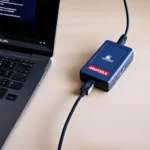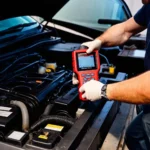“If you want to go fast, go alone. If you want to go far, go together.” This African proverb perfectly illustrates the importance of a well-functioning car. And just like any complex system, sometimes your car’s brain – the ECU (Engine Control Unit) – needs a little refresh.
That’s where reflashing, or reprogramming, comes in. It’s like giving your car’s ECU a software update, often resulting in improved performance, fuel efficiency, and even fixing those pesky glitches that have been driving you crazy. And when it comes to reflashing, Autel diagnostic tools have become a favorite among car enthusiasts and professionals alike.
But how exactly do you reflash an ECU with an Autel scanner? Buckle up as we take you on a detailed journey, exploring the ins and outs of this increasingly popular procedure.
Understanding ECU Reflashing: More Than Just a Software Update
Before we jump into the how-to, let’s understand why reflashing your ECU can be beneficial.
Imagine this: you’ve been experiencing sluggish acceleration, and your fuel economy seems to have taken a nosedive. You take your car to a mechanic, and after a quick scan, they tell you it’s not a mechanical issue, but your ECU needs a reflash.
ECU reflashing essentially involves updating the software that controls your engine and other crucial components. This software, also known as the firmware, dictates how your car responds to different driving conditions. Over time, car manufacturers release updated firmware versions to:
- Improve performance: Enhanced horsepower, torque, and throttle response.
- Enhance fuel economy: Optimized engine parameters for better fuel efficiency.
- Address drivability issues: Resolve issues like rough idling, hesitation, or stalling.
- Install new features: Activate features that weren’t initially available.
Think of it as giving your car’s brain a tune-up, allowing it to perform at its best and adapt to the latest advancements.
Autel Scanners: Your Gateway to ECU Reflashing
Now, you might be wondering, why Autel specifically?
Autel has become a household name in the automotive diagnostic world, renowned for its user-friendly interfaces and powerful capabilities. Autel scanners, particularly the MaxiSys series, offer a comprehensive suite of diagnostic and programming functions, including ECU reflashing for a wide range of car makes and models.
These tools provide a direct link to your car’s ECU, allowing you to:
- Read and clear diagnostic trouble codes: Identify the root cause of any warning lights on your dashboard.
- View live data streams: Monitor various engine parameters in real-time, such as RPM, coolant temperature, and oxygen sensor readings.
- Perform active tests: Command different components to operate, aiding in pinpointing faulty sensors or actuators.
- And of course, reflash the ECU: Update the firmware to the latest version.
How to Reflash ECU with Autel: A Step-by-Step Guide
While the exact process may vary slightly depending on the specific Autel scanner model and car make, the general steps remain relatively similar.
Important: Before attempting to reflash your ECU, it’s crucial to have a stable internet connection and ensure your car’s battery is fully charged to avoid interruptions during the process, which could potentially damage your ECU.
Here’s a general overview of the steps involved:
1. Gather the Necessary Information:
- Autel Scanner: Ensure you have a compatible Autel scanner model that supports ECU reflashing for your specific car make and model.
- Vehicle Identification Number (VIN): This 17-digit code is usually found on your dashboard or driver’s side door jamb. You’ll need it to download the correct firmware for your car.
- Stable Internet Connection: A strong and stable internet connection is crucial for downloading the firmware and ensuring a smooth reflashing process.
- Battery Charger (Recommended): Connecting your car’s battery to a charger is highly recommended to maintain a stable voltage throughout the reflashing procedure.
2. Prepare Your Car and Scanner:
- Park your car in a well-ventilated area: This allows for proper airflow and prevents any overheating issues.
- Turn off all accessories: This includes the radio, headlights, air conditioning, and any other electrical components that might draw power from the battery.
- Connect the Autel scanner to your car’s OBD-II port: This port is typically located under the dashboard on the driver’s side.
- Turn on the ignition but do not start the engine: This powers up the ECU and allows the scanner to communicate with it.
3. Access the ECU Reflashing Function:
- Power on the Autel scanner: Navigate through the menu to find the “ECU Programming” or “Software Update” section.
- Enter your car’s VIN: The scanner will use this information to identify your car’s make, model, and ECU type.
- Connect the scanner to the internet: This allows the scanner to access Autel’s online database to check for available firmware updates.
4. Download and Install the Firmware:
- If an update is available, follow the on-screen prompts to download it. The download time may vary depending on the size of the firmware file and your internet speed.
- Once the download is complete, the scanner will verify the integrity of the file. It will then begin the reflashing process, transferring the new firmware to your car’s ECU.
5. Monitor the Reflashing Process:
- Do not interrupt the reflashing process: This could potentially damage your ECU.
- The scanner will display a progress bar and estimated time remaining. The entire process can take anywhere from a few minutes to an hour or more, depending on the complexity of the update.
6. Verify Successful Reflashing:
- Once the reflashing is complete, the scanner will notify you. Turn off the ignition and disconnect the scanner from the OBD-II port.
- Start your car and check for any warning lights. If everything went smoothly, your car should start normally, and any previous drivability issues related to the ECU should be resolved.
FAQs about ECU Reflashing with Autel
1. Is it safe to reflash my ECU with an Autel scanner?
Reflashing your ECU with a reputable and compatible tool like an Autel scanner is generally safe when done correctly. However, it’s essential to follow the instructions carefully and ensure a stable power supply throughout the process to minimize any risks.
2. Can I revert to the previous ECU firmware version if I encounter issues?
In most cases, it’s possible to revert to the previous firmware version. However, it’s best to consult with a qualified mechanic or Autel support for guidance.
3. How often should I reflash my ECU?
It’s not necessary to reflash your ECU regularly. It’s typically only required when there’s an update available that addresses specific issues or improves performance.
4. Will reflashing my ECU void my car’s warranty?
Reflashing your ECU with aftermarket firmware can potentially void your car’s warranty. It’s crucial to check with your car manufacturer or dealer before attempting any ECU modifications.
Exploring Further: More Automotive Insights Await
Looking for more in-depth information on Autel scanners and other car diagnostic tools?
Check out our detailed guide on Autel MaxiSys VCM II Programming to delve deeper into the world of automotive diagnostics and programming.
Need Expert Assistance? We’re Here to Help!
Reflashing an ECU can seem daunting, but it doesn’t have to be. If you’re unsure about any step or need assistance, our team of automotive experts is just a message away. Contact us on WhatsApp at +84767531508 for 24/7 support. We’re here to guide you through the process and ensure your car is running at its best.
Remember: Your car is a complex machine. Taking care of its “brain” is just as crucial as maintaining its physical components. With the right tools and guidance, ECU reflashing can unlock a world of benefits, giving you a smoother, more efficient, and enjoyable driving experience.



